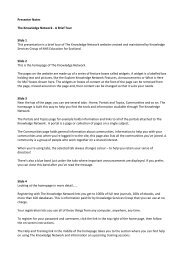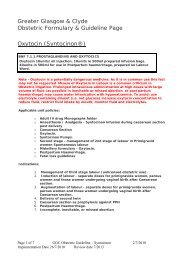The Fife Dementia Strategy: 2010 â 2020 - The Knowledge Network
The Fife Dementia Strategy: 2010 â 2020 - The Knowledge Network
The Fife Dementia Strategy: 2010 â 2020 - The Knowledge Network
Create successful ePaper yourself
Turn your PDF publications into a flip-book with our unique Google optimized e-Paper software.
4.6 Design for <strong>Dementia</strong><br />
AIM<br />
To provide services and facilities which are designed to meet the needs<br />
of people with dementia and do not increase the disability they<br />
experience. All new and refurbished buildings in <strong>Fife</strong> for use by older people<br />
or people with dementia are developed using the principles of dementia<br />
friendly design. Existing facilities which are not due for update are audited to<br />
determine the changes that can be made to increase their dementia<br />
friendliness. Such designs will also enable staff to provide higher quality<br />
services.<br />
RECOMMENDATIONS TO ACHIEVE THIS<br />
4.6.1 Ensure facility and service planners and developers are aware of<br />
the unique needs of people with dementia; and that they understand the<br />
importance of using dementia friendly principles in the design of public<br />
buildings and buildings that may be used by older people. This will<br />
include: housing, care homes, respite and day care facilities, health care<br />
facilities including hospitals and clinics, and other buildings for public use and<br />
particularly older people.<br />
Research indicates that the using dementia design principles in a building can<br />
play an important role in supporting activities and positively impacting wellbeing<br />
35 , and that poor design may negatively impact behaviour, promoting<br />
restlessness, anxiety and disorientation in people with dementia 36 . <strong>The</strong> term<br />
‘dementia friendly design’ refers to a wide array of structural and interior<br />
design features which do not hinder people with dementia by increasing their<br />
functional or psychological disabilities, and in fact can lead to improved quality<br />
of life. Where possible these features should be adapted to the needs and<br />
wishes of each individual and will commonly include 37 :<br />
• Utilisation of as much natural light as possible;<br />
• Ensuring rooms are adequately lit;<br />
• Using signage to assist in way-finding and preventing disorientation;<br />
• Ensuring adequate toilet facilities are available, visible and sign-posted;<br />
• In care homes using small units with a small number of people;<br />
• Providing adequate space for those who like to walk to do so without<br />
encountering barriers or closed doors;<br />
• Providing safe outdoor spaces where people with dementia can walk or<br />
sit and enjoy the smells, sites, sounds and various textures;<br />
35 Torrington, J. (2006). What has architecture got to do with dementia care? Explorations of<br />
the relationship between building design and quality of life in two EQUAL projects. Quality in<br />
Aging. 7(1): 34-49.<br />
36 Elmstahl S, Annerstedt L & Ahlund O (1997). How should a group living unit for demented<br />
elderly be designed to decrease psychiatric symptoms? Alzheimer Disease and Associated<br />
Disorders. 11(1): 47-52.<br />
37 Best Practice in Design for People with <strong>Dementia</strong> (2007). University of Stirling, <strong>Dementia</strong><br />
Services Development Centre.<br />
47
















